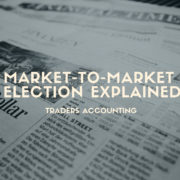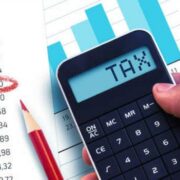When does the IRS Consider You a Trader?
 One of the most important considerations when you begin to trade is taxes. There are special rules that apply specifically to traders and not investors. Essentially, United States law considers your trading activity as a business, even if you don’t have any employees.
One of the most important considerations when you begin to trade is taxes. There are special rules that apply specifically to traders and not investors. Essentially, United States law considers your trading activity as a business, even if you don’t have any employees.
This comes with the tax advantages that are part of owning a business and is known as trader tax status. This status will grant you the ability to deduct interest as an expense, deduct educational expenses such as seminars, and, possibly, deduct home office costs if you work from home.
This status also allows traders to make an election called “mark to market.” While you would normally only be able to write off $3,000 worth of trading losses while filing taxes, this allows you to claim greater losses, if applicable.
However, to be eligible for any of this, you must meet certain conditions in the eyes of the Internal Revenue Service. Here are a few ways to tell if the IRS is likely to consider you a trader:
Your Trading Activity
It’s important to first understand the difference between trading and investing. Essentially, investors make their money from dividends, interest and capital appreciation while traders make theirs from daily stock movements. Investing is about looking at the long term while trading is all about the day-to-day. Of course, you can be both a trader and investor, but the special rules for traders will not apply to any securities held for investment.
Additionally, the IRS wants to see that you trade frequently, regularly, substantially, and continuously. To be considered a part-time or full-time trader, you have to spend at least four hours a day trading. This time can include, research, administration, traveling to meetings, and anything that has to do with the job. A full-time trader can have some lapses in trading for vacations, illness, and holidays, much like you would in a standard job.
The IRS also wants to see that you execute trades about 75% of the week, or at least four of the five market days in a given week. The vast majority of these trades should be day trades or swing trades.
Your Intentions
The IRS also wants to see that your activity shows that your goal is to make profit on the short-term swings in the price of securities. Additionally, you must have at least $25,000 on deposit with a broker in the United States, which gives you the right to be called a pattern day trader. This shows that you’re serious about making frequent trades for profit.
You also have to show that your intention is to trade as a business in order to make a living. This doesn’t mean it has to be your exclusive source of income, but it does mean you need to be using your own money for the trades.
Equipment is also an important consideration here – it might not be enough to just make trades from your phone. Most traders have multiple monitors, subscriptions, cloud services, all located in an office.
Your Communication to the IRS
If you want to achieve active trader tax status, you have to do so ahead of time by making a mark to market election. You have to provide a tax return from the previous year, Form 4868 or the Application for Automatic Extension of Time To File U.S. Individual Income Tax Return, and a written declaration of your intention to make a mark to market election. The IRS will respond with their decision.
If you need any help along the way, Traders Accounting offers mark to market election coaching. And when you do achieve active trader tax status, we can help you file a complete and accurate tax return. Contact us today to learn more about our services.












Leave a Reply
Want to join the discussion?Feel free to contribute!